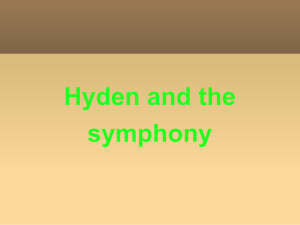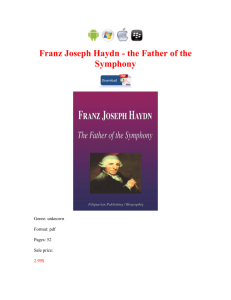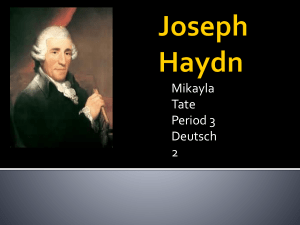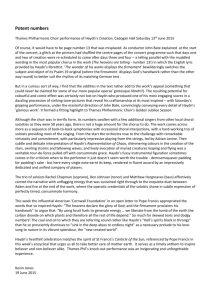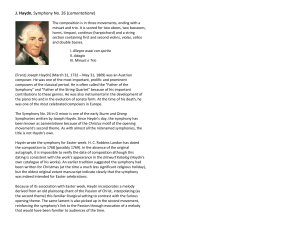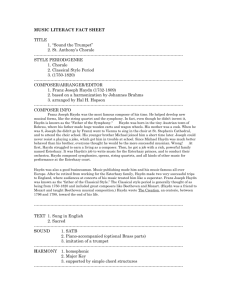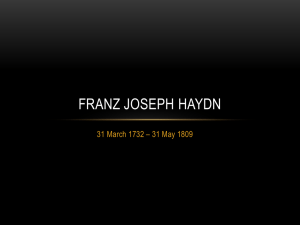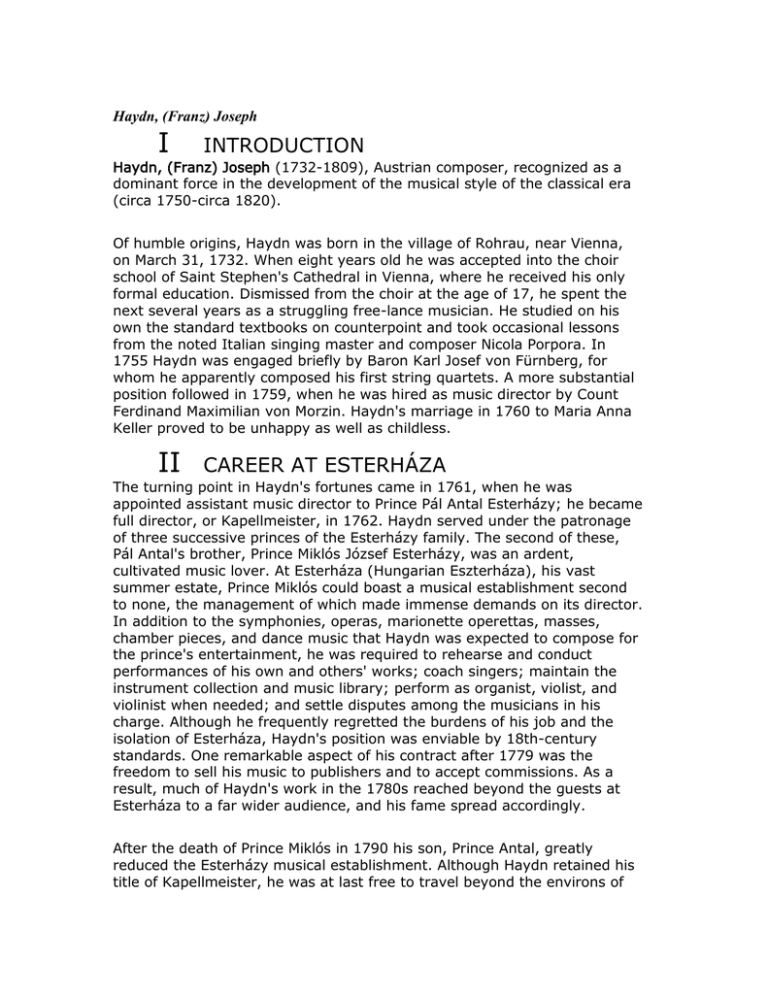
Haydn, (Franz) Joseph
I
INTRODUCTION
Haydn, (Franz) Joseph (1732-1809), Austrian composer, recognized as a
dominant force in the development of the musical style of the classical era
(circa 1750-circa 1820).
Of humble origins, Haydn was born in the village of Rohrau, near Vienna,
on March 31, 1732. When eight years old he was accepted into the choir
school of Saint Stephen's Cathedral in Vienna, where he received his only
formal education. Dismissed from the choir at the age of 17, he spent the
next several years as a struggling free-lance musician. He studied on his
own the standard textbooks on counterpoint and took occasional lessons
from the noted Italian singing master and composer Nicola Porpora. In
1755 Haydn was engaged briefly by Baron Karl Josef von Fürnberg, for
whom he apparently composed his first string quartets. A more substantial
position followed in 1759, when he was hired as music director by Count
Ferdinand Maximilian von Morzin. Haydn's marriage in 1760 to Maria Anna
Keller proved to be unhappy as well as childless.
II
CAREER AT ESTERHÁZA
The turning point in Haydn's fortunes came in 1761, when he was
appointed assistant music director to Prince Pál Antal Esterházy; he became
full director, or Kapellmeister, in 1762. Haydn served under the patronage
of three successive princes of the Esterházy family. The second of these,
Pál Antal's brother, Prince Miklós József Esterházy, was an ardent,
cultivated music lover. At Esterháza (Hungarian Eszterháza), his vast
summer estate, Prince Miklós could boast a musical establishment second
to none, the management of which made immense demands on its director.
In addition to the symphonies, operas, marionette operettas, masses,
chamber pieces, and dance music that Haydn was expected to compose for
the prince's entertainment, he was required to rehearse and conduct
performances of his own and others' works; coach singers; maintain the
instrument collection and music library; perform as organist, violist, and
violinist when needed; and settle disputes among the musicians in his
charge. Although he frequently regretted the burdens of his job and the
isolation of Esterháza, Haydn's position was enviable by 18th-century
standards. One remarkable aspect of his contract after 1779 was the
freedom to sell his music to publishers and to accept commissions. As a
result, much of Haydn's work in the 1780s reached beyond the guests at
Esterháza to a far wider audience, and his fame spread accordingly.
After the death of Prince Miklós in 1790 his son, Prince Antal, greatly
reduced the Esterházy musical establishment. Although Haydn retained his
title of Kapellmeister, he was at last free to travel beyond the environs of
Vienna. The enterprising British violinist and impresario Johann Peter
Salomon lost no time in engaging the composer for his concert series in
London. Haydn's two trips to England for these concerts, in 1791-92 and
1794-95, were the occasion of the huge success of his last symphonies.
Known as the “Salomon” or “London” symphonies, they include several of
his most popular works: Surprise (no. 94), Military (no. 100), Clock (no.
101), Drum Roll (no. 103), and London (no. 104).
In his late years in Vienna, Haydn turned to writing masses and composed
his great oratorios, The Creation (1798) and The Seasons (1801). From this
period also comes his “Emperor's Hymn” (1797), which later became the
Austrian national anthem. He died in Vienna, on May 31, 1809, a famous
and wealthy man.
III
EVALUATION
Haydn was prolific in nearly all genres, vocal and instrumental, sacred and
secular. Many of his works were unknown beyond the walls of Esterháza,
most notably the 125 trios and other assorted pieces featuring the baryton,
a hybrid string instrument played by Prince Miklós. Most of Haydn's 19
operas and marionette operettas were written to accommodate the talents
of the Esterháza company as well as the tastes of his prince. Haydn freely
admitted the superiority of the operas of his young friend Wolfgang
Amadeus Mozart. In other categories, however, his works circulated widely,
and his influence was profound. The 107 symphonies and 68 string quartets
that span his career are proof of his ever-fresh approach to thematic
materials and form, as well as of his mastery of instrumentation. His 62
piano sonatas and 43 piano trios document a growth from the easy
elegance suitable for the home music making of amateurs to the public
virtuosity of his late works.
Haydn's productivity is matched by his inexhaustible originality. His manner
of turning a simple tune or motive into unexpectedly complex
developments was admired by his contemporaries as innovative. Dramatic
surprise, often turned to humorous effect, is characteristic of his style, as is
a fondness for folklike melodies. A writer of Haydn's day described the
special appeal of his music as “popular artistry,” and indeed his balance of
directness and bold experiment transformed instrumental expression in the
18th century.
Contributed By:
Gretchen A. Wheelock
1
1"Haydn, (Franz) Joseph."Microsoft® Encarta® Encyclopedia 2001. © 1993-2000
Microsoft Corporation. All rights reserved.

